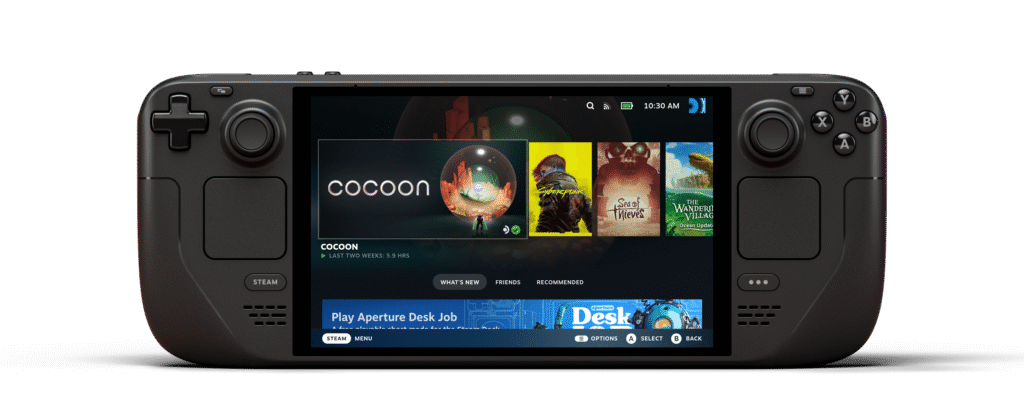The Steam Deck 2 is a powerful handheld gaming device—but even with its upgraded specs, some users experience frustrating lag, frame drops, or stuttering during gameplay.
If you’re one of them, don’t worry—you’re not alone, and you’re definitely not stuck. Whether it’s AAA titles lagging unexpectedly or indie games stuttering, there are clear steps you can take to improve performance.
In this comprehensive guide, we’ll walk through everything you need to know about troubleshooting lag on the Steam Deck 2, from the most common issues to expert-level optimization tricks.
🚨 Common Signs of Game Lag on Steam Deck 2
Before diving into fixes, let’s quickly identify what counts as “lag” on the Deck:
-
Frame drops or stuttering
-
Input delay or controller lag
-
Freezing or temporary game lockups
-
Slow loading times or delayed UI response
The good news? Almost all of these issues can be fixed through a combination of in-game settings, SteamOS optimizations, and hardware-aware tweaks.
🎮 Why Games Lag on Steam Deck 2 (Even with Great Hardware)
The Steam Deck 2 boasts significant upgrades over its predecessor: a faster APU, better cooling, a higher refresh display, and improved battery life. So why are you seeing lag?
Here are the most common causes:
-
Games not optimized for Steam Deck 2
-
Incorrect performance settings
-
Thermal throttling
-
Background processes eating system resources
-
Shader caching issues
-
Proton compatibility problems (for non-native games)
✅ Top Fixes for Steam Deck 2 Game Lag
Let’s go step-by-step through the most effective troubleshooting methods. These work for both native Linux games and Windows games running via Proton.
1. Lower In-Game Graphics Settings First
High-resolution textures, shadows, and effects may crush performance even on powerful handhelds. Start here:
-
Lower resolution to 720p or native Deck res (800p/1080p)
-
Turn off or reduce:
-
Anti-aliasing
-
Shadow quality
-
Reflections
-
Motion blur
-
-
Use FSR (FidelityFX Super Resolution) where available for massive FPS boosts
💡 Pro Tip: Even reducing settings slightly can bring FPS from 30 → 60 in many games.
2. Enable Steam Deck Performance Overlay
Steam Deck 2 includes a built-in FPS and performance monitoring overlay. Enable it:
-
Press the “…” (Quick Access button)
-
Go to Performance tab
-
Turn on Performance Overlay Level 3 or 4
This helps you track:
-
Real-time FPS
-
GPU/CPU usage
-
Thermal behavior
From here, you can spot what’s causing the bottleneck.
3. Adjust TDP and GPU Clock in Performance Settings
Sometimes your Deck is drawing too much or too little power. Steam Deck 2 lets you fine-tune this:
-
Go to Quick Access > Performance Settings
-
Set:
-
TDP Limit (start with 10W or 12W for intensive games)
-
GPU Clock Speed Limit (adjust based on stutters)
-
For lighter games, lower TDP saves battery without impacting FPS. For heavy games, you may need to increase TDP to maintain performance.
4. Use Proton GE for Better Compatibility
If you’re playing non-native games (especially from Windows), try Proton GE—a custom version of Proton that improves compatibility and performance.
How to install:
-
Use the ProtonUp-Qt tool (available in Desktop Mode)
-
Install latest Proton GE version
-
Force the game to use it in Game Properties > Compatibility
Many users report smoother performance and fewer crashes with Proton GE.
5. Clear Shader Cache
Games using Vulkan or DX12 sometimes lag due to shader stuttering.
Fix:
-
Go to Settings > Storage
-
Select game > Clear Shader Cache
Then relaunch the game. It may stutter briefly on first boot, but then smooth out as the cache rebuilds properly.
6. Close Background Apps
You’d be surprised how many processes run in the background—even on Steam Deck.
-
Hit Steam + X and go to System Monitor
-
Close background downloads, update checkers, and browser tabs (especially in Desktop Mode)
This frees up RAM and CPU headroom.
7. Turn Off Cloud Sync Mid-Game
Sometimes syncing saves to the cloud can cause small freezes. Try turning off Steam Cloud temporarily:
-
Right-click game > Properties > Uncheck “Keep saves in the Steam Cloud”
Just be sure to re-enable it if you need cross-device saves later.
8. Update SteamOS and GPU Drivers
Performance patches are regularly rolled out for Steam Deck 2. Keep your system up to date:
-
Go to Settings > System > Check for Updates
-
Install any SteamOS or firmware updates
If you’re using Windows on your Steam Deck 2, install latest AMD drivers manually via official AMD site.
9. Try Game Mode vs Desktop Mode
While Desktop Mode is great for multitasking, it’s not optimized for gaming. Make sure you’re running games in Game Mode, which is lighter and GPU-prioritized.
10. Use CryoUtilities for Advanced Optimization
If you’re comfortable with advanced tweaks, check out CryoUtilities, a popular performance tool for Steam Deck.
It allows:
-
Pagefile resizing
-
Swap file improvements
-
RAM compression management
Be cautious—read documentation carefully—but many users report FPS increases of 10–30% in demanding titles.
⚙️ Game-Specific Fixes: Titles Known to Lag
Some games have their own quirks. Here are quick notes for common laggy games on Steam Deck 2:
🎯 Elden Ring
-
Use Proton GE
-
Enable FSR
-
Cap framerate to 40 for stability
🧟 The Last of Us Part I
-
Set to Medium or Low settings
-
Install shaders fully before playing
-
TDP: 13–15W recommended
🛡 Cyberpunk 2077
-
Use FSR 2.1
-
Reduce crowd density and shadows
-
TDP: 15W+
-
GPU Clock: 1600–1800 MHz
🧠 Bonus Tips: Lag-Free Experience
-
Restart Steam Deck regularly – keeps memory clean
-
Switch to Performance mode (instead of Battery saver)
-
Use SD cards with UHS-I/UHS-II support for faster game loading
-
Enable Game Mode scaling in Accessibility for smoother visuals
🚀 When to Reset or Reinstall
If none of the above helps:
-
Try Verifying game files via Steam
-
As a last resort, reinstall the game
-
If system-wide issues persist, consider SteamOS reset (backup saves first)
🎉 Conclusion: You Can Play Lag-Free on Steam Deck 2
The Steam Deck 2 is a powerhouse—but like any PC-like system, it needs a little tuning. With the tips above, you can:
-
Fix frame drops
-
Improve game stability
-
Customize settings for max performance without overheating
-
Enjoy smooth gaming on the go or docked
No more stuttering, no more lag. Just buttery-smooth gameplay—anywhere, anytime.





